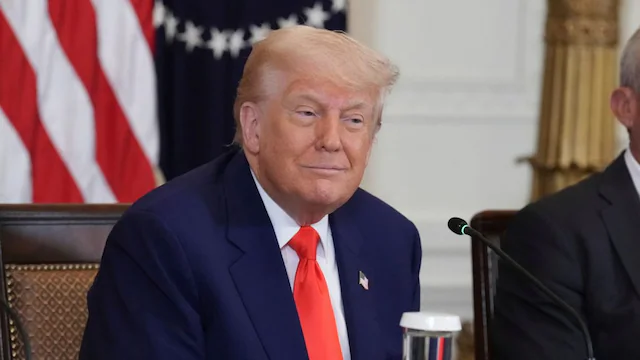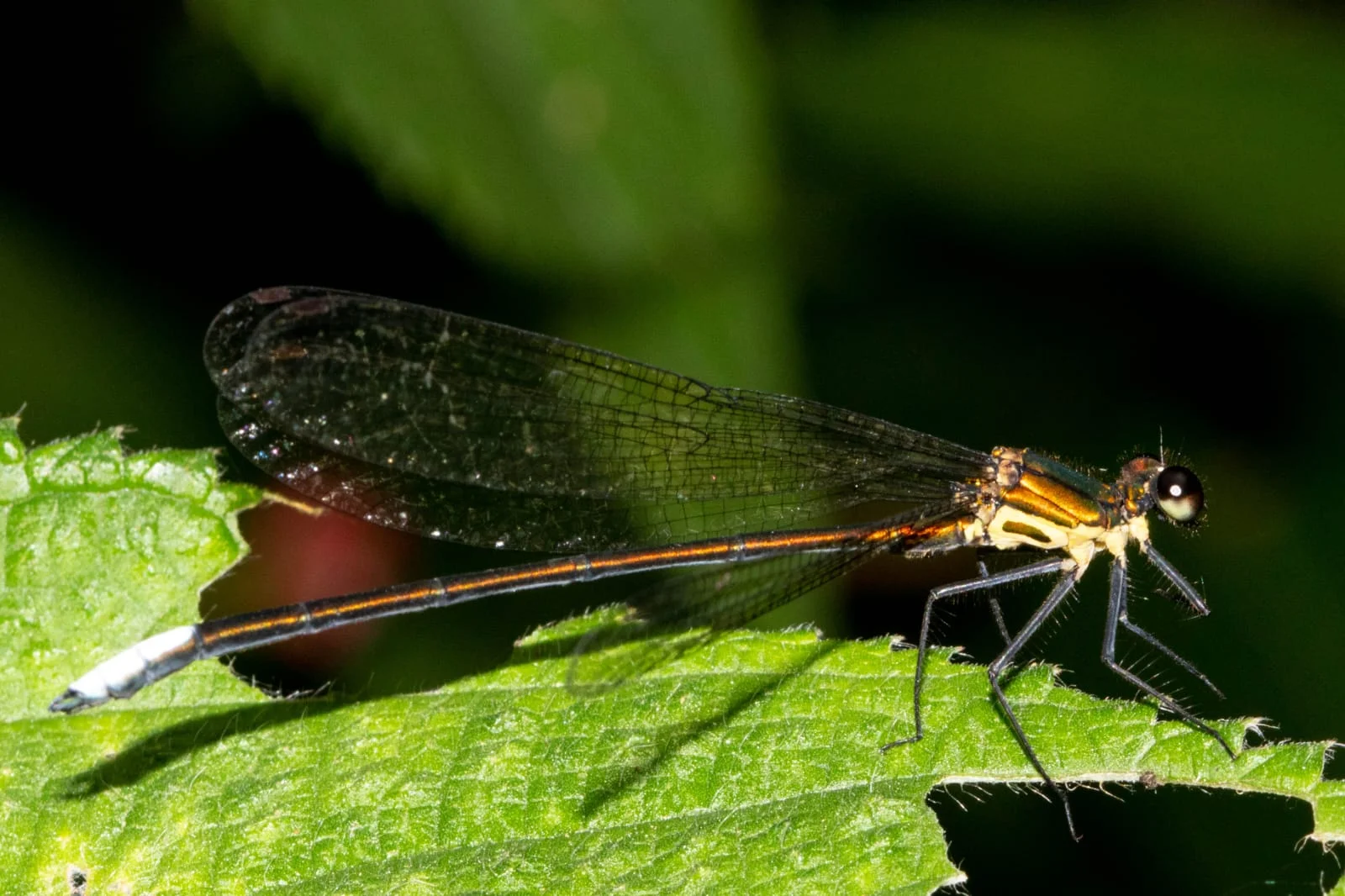- Courses
- GS Full Course 1 Year
- GS Full Course 2 Year
- GS Full Course 3 Year
- GS Full Course Till Selection
- Online Program
- GS Recorded Course
- NCERT (Recorded 500+ Hours)
- Polity Recorded Course
- Geography Recorded Course
- Economy Recorded Course
- AMAC Recorded Course
- Modern India, Post Independence & World History
- Environment Recoded Course
- Governance Recoded Course
- Science & Tech. Recoded Course
- International Relations and Internal Security Recorded Course
- Disaster Management Module Course
- Ethics Recoded Course
- Essay Recoded Course
- Current Affairs Recoded Course
- CSAT
- 5 LAYERED ARJUNA Mentorship
- Public Administration Optional
- ABOUT US
- OUR TOPPERS
- TEST SERIES
- FREE STUDY MATERIAL
- VIDEOS
- CONTACT US
Daily Current Affairs-May 19, 2023
Daily Current Affairs-May 19, 2023
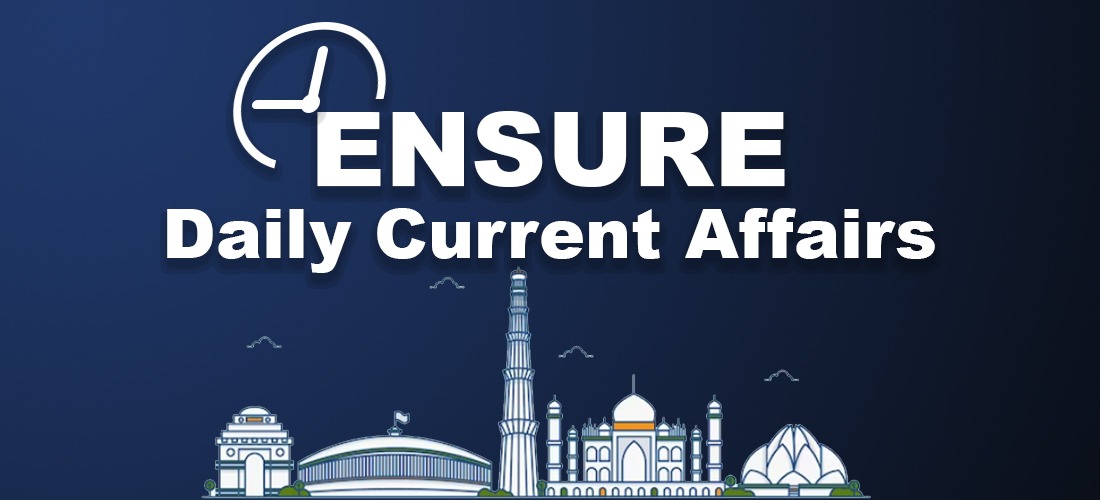
GREEN ENERGY OPEN ACCESS RULES 2022

Latest Context
Recently, a meeting on Green Energy Open Access Rules 2022 was chaired by the Ministry of Power & NRE (New and Renewable Energy), Government of India.
Green Energy Open Access Rules 2022
Introduction: To further accelerate India’s ambitious Renewable Energy Programmes, the government notified Electricity (Promoting Renewable Energy Through Green Energy Open Access) Rules, 2022 in order to ensure access to affordable, reliable, sustainable and Green Energy for all.
Objective: Its target is to cut emissions by 45% to comply with India’s updated NDC (Nationally Determined Contributions) target for 2030. These rules are notified to encourage the generation, purchase, and consumption of green energy in addition to generating the energy from Waste-to-Energy plants.
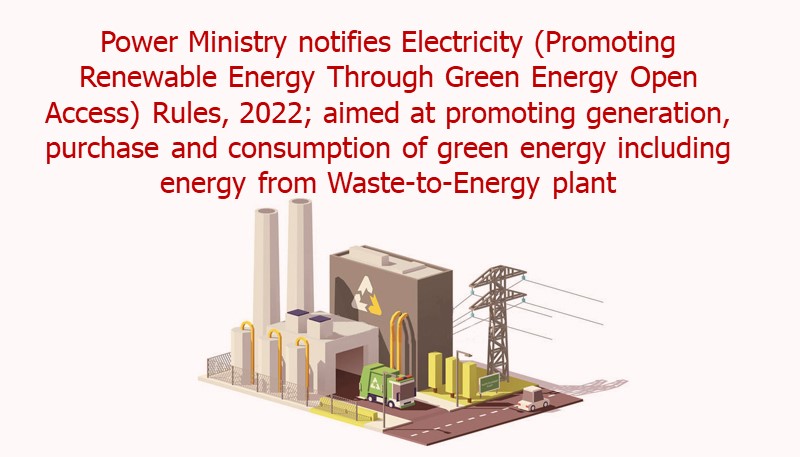
Key Features
- Permission is granted for any consumer to have access to Green Open Access and its limit has been reduced from 1 MW to 100 kW for green energy. It has been done to enable small consumers in addition to encouraging the purchase of renewable power through open access.
- There will be a provision of uniform Renewable Purchase Obligation (RPO). Green Hydrogen/Green Ammonia has also been included for the fulfilment of its RPO.
- Green Open Access would be allowed to any Open Access Consumer.
- Those individuals are called Captive Consumers who are bound or do not have any choice but to purchase a particular product or service due to various factors, like market conditions, lack of alternatives, or contractual obligations.
- The transaction limit for non-captive consumers will be a minimum of 100 KW, but there is no limit for captive consumers.
- Consumers are entitled to demand a supply of Green Power from Discoms. Discoms would be obligated to procure and supply green power to eligible consumers.
- Fifteen days are granted for approving the Green Open Access or else it will be deemed to have been granted.
- Commercial and Industrial consumers are allowed to purchase green power on a voluntary basis. Consumers will be given Green Certificates if they consume green power and will also be facilitated.
Significance
- To prompt smaller industries, commercial consumers, and large households to shift towards green energy this initiative has been taken.
- India added 1.2 GW of solar open-access installations in 2021, which grew by 22 % to 513 MW during January-March 2022.
- Hence, Green Open Access Rules 2022 are believed to be a huge stepping stone towards achieving India's commitment to 500 GW of non-fossil fuel energy by 2030.
Other Measures Related to Green Energy Transition
- National Smart Grid Mission (NSGM) and Smart Meter National Programme
- Pradhan Mantri Sahaj Bijli Har Ghar Yojana (SAUBHAGYA)
- Green Energy Corridor (GEC)
- International Solar Alliance (ISA)
- Faster Adoption and Manufacturing of (Hybrid &) Electric Vehicles (FAME)
- PM- KUSUM (Pradhan Mantri-Kisan Urja Suraksha evam Utthaan Mahabhiyan)

INDIA-EU TRADE AND TECHNOLOGY COUNCIL

Latest Context
Recently, India-European Union Trade and Technology Council (TTC)’s first Ministerial meeting took place in Brussels, Belgium. The second bilateral forum for the EU is the EU-India Trade and Technology Council and the first one established with any partner for India. A Trade and Technology Council (TTC) was launched by The EU and the US in June 2021.
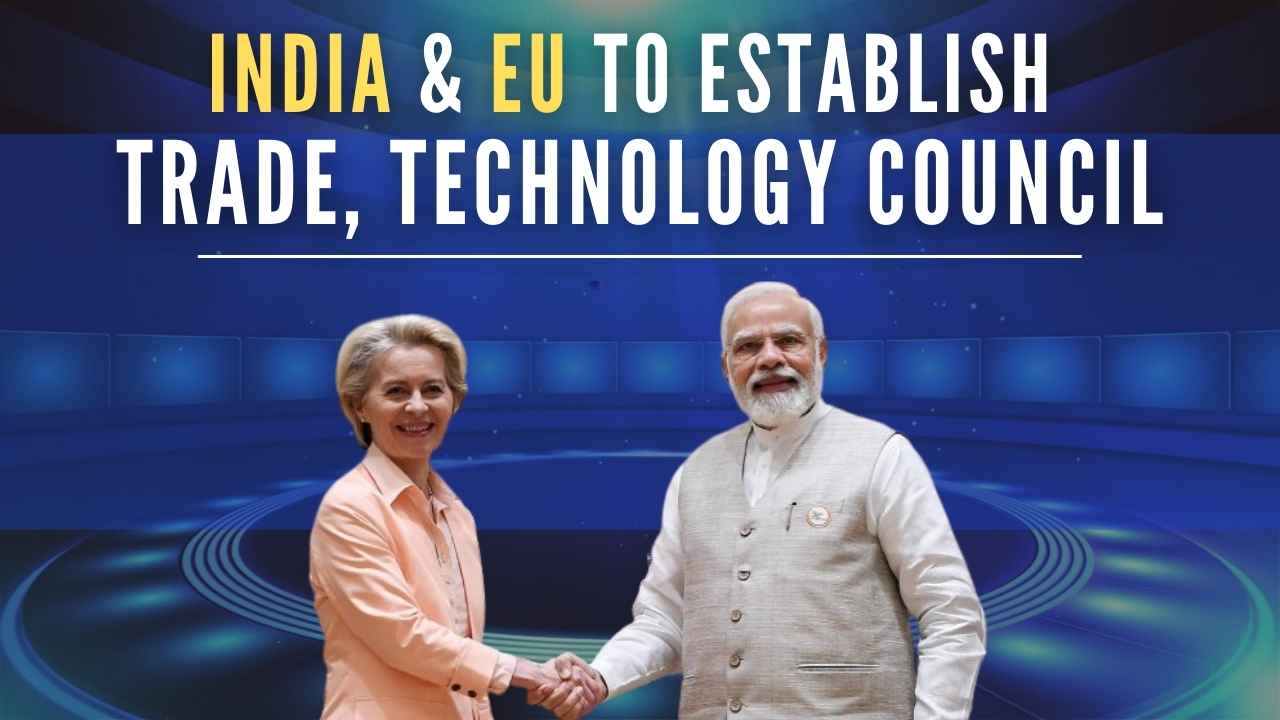
Main Points
Objective: Its motto is to provide direction and a roadmap for cooperation between the two sides with respect to
- Addressing mutual market access
- WTO (World Trade Organization) reforms
- The ongoing negotiations for a Free Trade Agreement (FTA)
- Cooperation in various areas of mutual interest
Roadmap for Future Cooperation: The Meeting involved discussions on roadmaps for future cooperation under the three working groups
- Strategic Technologies, Digital Governance, and Digital Connectivity
- Green and Clean Energy Technologies
- Trade, Investment, and Resilient Value Chains
Carbon Border Adjustment Mechanism (CBAM): India and the EU are also working to resolve the issues related to E.U.’s Carbon Border Adjustment Mechanism (CBAM). According to the EU, it is a “landmark tool” which places a “fair price” on the emission of carbon during the production of goods which enter the EU. In addition, it is also a mechanism to “encourage cleaner industrial production” outside the EU.
India-EU Trade and Technology Council (TTC)
- Formation and its Objective: In 2022, the Indian Prime Minister and President of the European Commission announced its formation with the aim of creating a High-level coordination platform to handle the strategic challenges at the nexus of trade, trusted technology and security.
- Meetings: Its Ministerial Meetings will be held annually to ensure regular high-level engagement between India and the EU. They will take place alternatively in terms of location, either in India or in the EU, to foster balanced participation and strengthen bilateral cooperation.
Working Groups (WG): It consists of three Working Groups (WGs) that report on roadmaps for future cooperation
- Working Group on Trade, Investment, and Resilient Value Chains: Its main target is to work on the resilience of supply chains and access to critical components, energy, and raw materials. In addition, it will also work to resolve identified trade barriers and global trade challenges by promoting cooperation in multilateral forums. It will also work towards the promotion of international standards and cooperation in addressing global geopolitical challenges.
- Working Group on Strategic Technologies, Digital Governance, and Digital Connectivity: Its main target is to work jointly on areas of mutual interest like digital connectivity, Artificial Intelligence, high performance and Quantum Computing, 5G/6G, semiconductors, cloud systems, Cybersecurity, digital skills and digital platforms.
- Working Group on Green and Clean Energy Technologies: The main objective of this group is to lay emphasis on green technologies, including investment and standards, research and innovation. It will also work on the areas that have to be explored. These areas are clean energy, circular economy, waste management, plastic and litter in the ocean, waste to hydrogen and recycling of batteries for e-vehicles. It will also promote cooperation between EU and Indian incubators, SMEs and start-ups.
Significance
- It will provide political guidance and the necessary structure to effectively implement political decisions, coordinate technical endeavours, and ensure accountability at the political level.
- It will also work to identify the evolving geopolitical landscape so that both India and the EU can work together by acknowledging the importance of establishing a strong collaborative framework.
- It will help in increasing the EU-India bilateral trade, which is at historical highs as the Euro traded 120 billion worth of goods in 2022. In 2022 too, EURO 17 billion of digital products and services were traded.
Significance of the EU for India
- Employment: It works closely with India to promote peace, create jobs, boost economic growth and enhance sustainable development across the country.
- Financial Assistance: Since India has emerged as a low to medium-income country (OECD 2014), the EU-India cooperation has also evolved from traditional financial assistance to a partnership with a focus on common priorities.
- Exports: The merchandised exports of India with EU member countries were at about USD 65 billion in 2021-22, while imports aggregated at USD 51.4 billion. In 2022-23, the exports aggregated at USD 67 billion, whereas its imports were at USD 54.4 billion in 2021-22.
- Trade: India’s 2nd-largest trading partner (after the US) is the EU and it is also India’s 2nd-largest export market. India is the EU's 10th largest trading partner and accounts for 2% of EU’s total trade in goods. Trade in services between the EU and India reached 40 billion euros in 2021.
- Other Bilateral Mechanism: Leaders reiterated their intention to strengthen cooperation on the implementation of the 2030 Agenda for Sustainable Development and agreed to explore the continuation of the EU-India Development Dialogue at the 2017 EU-India Summit.
European Union
- The European Union is a group of 27 countries that works as a cohesive economic and political block. Nineteen countries of this group use Euro (€) as their official currency. Eight EU members (Bulgaria, Croatia, Czech Republic, Denmark, Hungary, Poland, Romania and Sweden) do not use the euro.
- The formation of the EU as a single European political entity was the result of ending centuries-long warfare among European countries that culminated with World War II. It has developed an internal single market through a standardised system of laws that apply to all member states in matters where members have agreed to act as one.

Prelims:
Q. ‘Broad-based Trade and Investment Agreement (BTIA)’ is sometimes seen in the news in the context of negotiations held between India and (2017)
(a) European Union
(b) Gulf Cooperation Council
(c) Organization for Economic Cooperation and Development
(d) Shanghai Cooperation Organization
Ans: (a)
Q. In the context of bilateral trade negotiations between India and European Union, what is the difference between European Commission and European Council? (2010)
1. The European Commission represents the EU in trade negotiations whereas European Council participates in the legislation of matters pertaining to economic policies of the European Union.
2. The European Commission comprises the Heads of State or government of member countries whereas the European Council comprises of the persons nominated by European Parliament.
Which of the statements given above is/are correct?
(a) 1 only
(b) 2 only
(c) Both 1 and 2
(d) Neither 1 nor 2
Ans: (d)

GROUNDWATER EXTRACTION AND LAND SUBSIDENCE

Latest Context
Recently, Joshimath in Uttarakhand has become a cause of concern. Similarly, the plains of the Punjab, Haryana, Delhi, and Faridabad have been in the national news due to only one reason which is excessive groundwater extraction. According to Central Ground Water Extraction (CGWE) excessive groundwater extraction is the main reason for these events that are creating a very difficult situation for the Joshimath region especially.
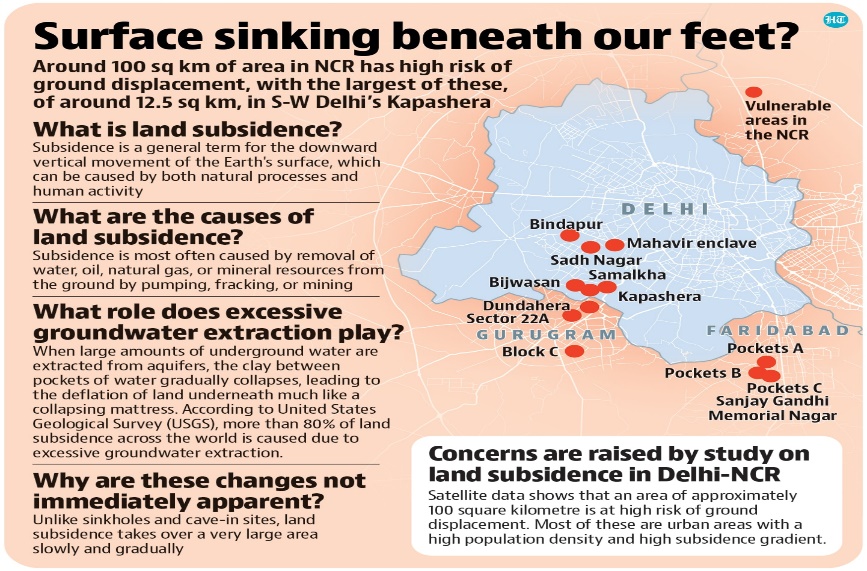
Land Subsidence
-
Conceptual Framework: Due to the compaction of underground layers of soil, rock, or other materials, the gradual sinking or settling of the Earth's surface takes place. It takes place when the support structures below the land, like underground mines, aquifers, or natural gas extraction, are depleted or when certain geological processes take place.
-
Effect of Land Slide: It results in damaging the infrastructure, including roads, buildings, and underground utilities in urban areas. Land Subsidence can increase the risk of flooding in coastal regions by reducing the elevation of the land relative to sea level. It can disrupt the flow of water in rivers and canals, affect irrigation systems, and cause permanent damage to farmland in agricultural areas
Report of Central Ground Water Extraction (CGWE)
-
Groundwater Extraction: For mining activities, digging is done very extensively which results in the occurrence of "soil settlement". It also creates the voids or sinking of the land created. According to some researchers, attention should be paid to investigating the role of groundwater extraction in land subsidence in India.
-
Evidence of Land Subsidence in Different Regions: Land Subsidence from groundwater extraction was gradual and barely visible annually in comparison to the land movement from landslides or earthquakes. Building deformities that are the result of groundwater withdrawals have been identified by the studies based on satellite-based analysis of ground movement. Unplanned growth and rapid urbanization increased groundwater withdrawal and contributed to subsidence in the NCR. In addition to this, other parts of India like Kolkata are also facing the problem of overexploitation of groundwater blocks and land subsidence.
Status of Ground Water Extraction in India
- Currently, 85% of the rural and 50% of the urban population depends upon groundwater for sustenance which makes India is the largest groundwater user globally. According to the report on the National Compilation of Dynamic Ground Water Resources, India’s stage of groundwater extraction, which is the percentage of utilization of groundwater against recharge, has dropped from 61.6%in 2020 to 60.08% in 2022.
- The agricultural practices in North-West India heavily depend on groundwater withdrawal due to limited monsoon rain. CGWB data shows alarming levels of groundwater exploitation.
- Punjab: Over-exploitation of 76% of groundwater blocks
- Chandigarh: Over-exploitation of 64% of groundwater blocks
- Delhi: Over-exploitation of approximately 50% of groundwater blocks
Issues Associated
-
Emphasis on Water-Intensive Crops: The minimum support price plays a vital role in choosing the plantation of crops. For instance, MSP for wheat and rice creates highly skewed incentive structures in favour of wheat and paddy which are water-intensive crops and depend heavily on groundwater for their growth. It makes groundwater a heavenly resource for their farming.
-
Ecological Impacts: Depletion of Groundwater resources impacts ecosystems by changing the flow of water in rivers, lakes, and wetlands. It causes disruption in the natural balance, harming aquatic life and biodiversity. In addition, it also affects the availability of water for plants and animals dependent on groundwater sources.
-
Unregulated Pumping: In India, there are many states which are severely affected by groundwater depletion. But despite it, they provide free or subsidized power including solar pumps. It leads to the overexploitation and depletion of scarce groundwater resources.
-
Saline Water Intrusion: In coastal areas, excessive groundwater pumping is the main reason that causes saline water intrusion. When fresh groundwater gets depleted, seawater infiltrates into the aquifers which makes the water unsuitable for various uses and adversely impacts agriculture and ecosystems.
Government Measures Related to Groundwater Conservation
- Jal Shakti Abhiyan- Catch the Rain Campaign
- Pradhan Mantri Krishi Sinchayee Yojana
- Atal Bhujal Yojana
- Atal Mission for Rejuvenation and Urban Transformation (AMRUT)
Way Forward
-
Technology and Monitoring: By leveraging the technology for real-time monitoring of groundwater levels, such as remote sensing, IoT devices, and data analytics groundwater extraction can be checked. It can also help in informed decision-making and enable prompt action to mitigate groundwater depletion.
-
Crop Diversification and Efficient Irrigation: It is a dire need to promote crop diversification and shift to more water-efficient irrigation techniques like drip irrigation and sprinkler systems.
-
Recycling and Reuse of Wastewater: There is a need to encourage the use of treated wastewater for non-potable purposes like industrial processes to reduce the reliance on freshwater sources and alleviate the pressure on groundwater extraction.

Prelims
Q.1 Which one of the following ancient towns is well known for its elaborate system of water harvesting and management by building a series of dams and channelizing water into connected reservoirs? (2021)
(a) Dholavira
(b) Kalibangan
(c) Rakhigarhi
(d) Ropar
Ans: (a)
Q.2 With reference to ‘Water Credit’, consider the following statements: (2021)
1. It puts microfinance tools to work in the water and sanitation sector.
2. It is a global initiative launched under the aegis of the World Health Organization and the World Bank.
3. It aims to enable the poor people to meet their water needs without depending on subsidies.
Which of the statements given above are correct?
(a) 1 and 2 only
(b) 2 and 3 only
(c) 1 and 3 only
(d) 1, 2 and 3
Ans: (c)
Mains
Q.1 What are the salient features of the Jal Shakti Abhiyan launched by the Government of India for water conservation and water security? (2020)
Q.2 Suggest measures to improve water storage and irrigation system to make its judicious use under the depleting scenario. (2020)

WHOLESALE PRICE INDEX

Latest Context
Recently, the Ministry of Commerce and Industry released data regarding the inflation rate based on the Whole Sale Price Index (WPI). It came down to (-)0.92 % in April. It has become negative for the first time in three years. The main reason behind this incidence is the high base effect and moderation in global commodity prices due to the relaxation in the price of food, fuel, and other input costs.
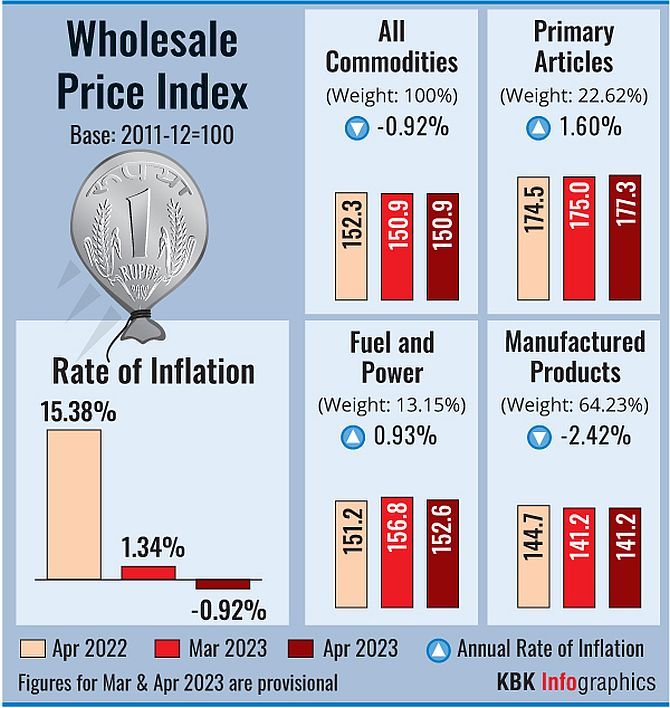
Wholesale Price Index (WPI)
Conceptual Framework: Through it, the changes in the prices of goods which has been sold and traded in bulk by wholesale businesses to other businesses are measured. Office of Economic Adviser under the Ministry of Commerce and Industry publishes WPI. It is the most widely used inflation indicator in India. This index is criticized on the basis that the general public does not buy products at wholesale prices. The base year of All-India WPI has been revised from 2004-05 to 2011-12 in 2017.
Weightage of WPI:
|
All Commodities/Major Groups |
Weightage |
Articles |
|
All Commodities |
100 |
|
|
1. Primary Articles |
22.6 |
Food Articles: Cereals, Paddy, Wheat, Vegetables, Potato, Onion, Milk, Eggs, Meat & Fish Non-Food Articles: Oil Seeds, Minerals, Crude Petroleum |
|
2. Fuel & Power |
13.2 |
LPG, Petrol, High-Speed Diesel |
|
3. Manufactured Goods |
64.2 |
Food Products: Vegetable and Animal Oils and Fats. Beverages: Chemical and Botanical Products, Tobacco Products, Wearing, Medicinal, Apparel, Pharmaceuticals and other Non-Metallic Mineral Products etc. |
|
4. Food Index |
24.4 |
‘Food Articles’ from the Primary Articles group and ‘Food Products’ from the Manufactured Products group constitute The Food Index consists. |
Factors Influencing WPI Inflation:
- Global Commodity Prices: Any change in global commodity prices affects WPI. In the current situation, it is expected that the decline in commodity prices will lower the inflation of manufactured products.
- Food Inflation and Monsoon Prospects: Monsson and food inflation also affect the WPI. Prices of Wheat affected by market conditions and monsoonal impact on the Kharif Crop result in a lower WPI.
- High Base Effect: The high base effect also resulted in lower WPI as per experts.
Difference Between WPI and CPI
|
Whole Sale Price Index |
Consumer Price Index |
|
WPI tracks inflation at Producer Level. The base year of WPI is 2011-12 |
CPI focuses on the inflation changes in price levels at the Consumer Level. The base year of CPI is 2012. |
|
It does not focus on the change in prices of the services |
CPI also measures the change in the prices of services. |
|
WPI gives more weightage to Manufactured Goods |
CPI gives more emphasis on food items. |
![]()
Prelims
Q.1 With reference to Indian economy, demand-pull inflation can be caused/increased by which of the following?
1. Expansionary policies
2. Fiscal stimulus
3. Inflation-indexing of wages
4. Higher purchasing power
5. Rising interest rates
Select the correct answer using the code given below:
(a) 1, 2 and 4 only
(b) 3, 4 and 5 only
(c) 1, 2, 3 and 5 only
(d) 1, 2, 3, 4 and 5
Ans: (a)
Q.2 Consider the following statements: (2020)
1. The weightage of food in the Consumer Price Index (CPI) is higher than that in Wholesale Price Index (WPI).
2. The WPI does not capture changes in the prices of services, which CPI does.
3. Reserve Bank of India has now adopted WPI as its key measure of inflation and to decide on changing the key policy rates.
Which of the statements given above is/are correct?
(a) 1 and 2 only
(b) 2 only
(c) 3 only
(d) 1, 2 and 3
Ans: (a)

RASHT-ASTARA RAILWAY

Latest Context
A recent agreement between Russia and Iran calls for the construction of the Rasht-Astara railway in Iran as part of the International North-South Transport Corridor (INSTC).
- The Rasht-Astara railway is considered a crucial link in the corridor, which aims to connect Russia, Iran, Azerbaijan, India, and other nations through rail and sea. According to Russia, this route can compete with the Suez Canal as a crucial global economic route.
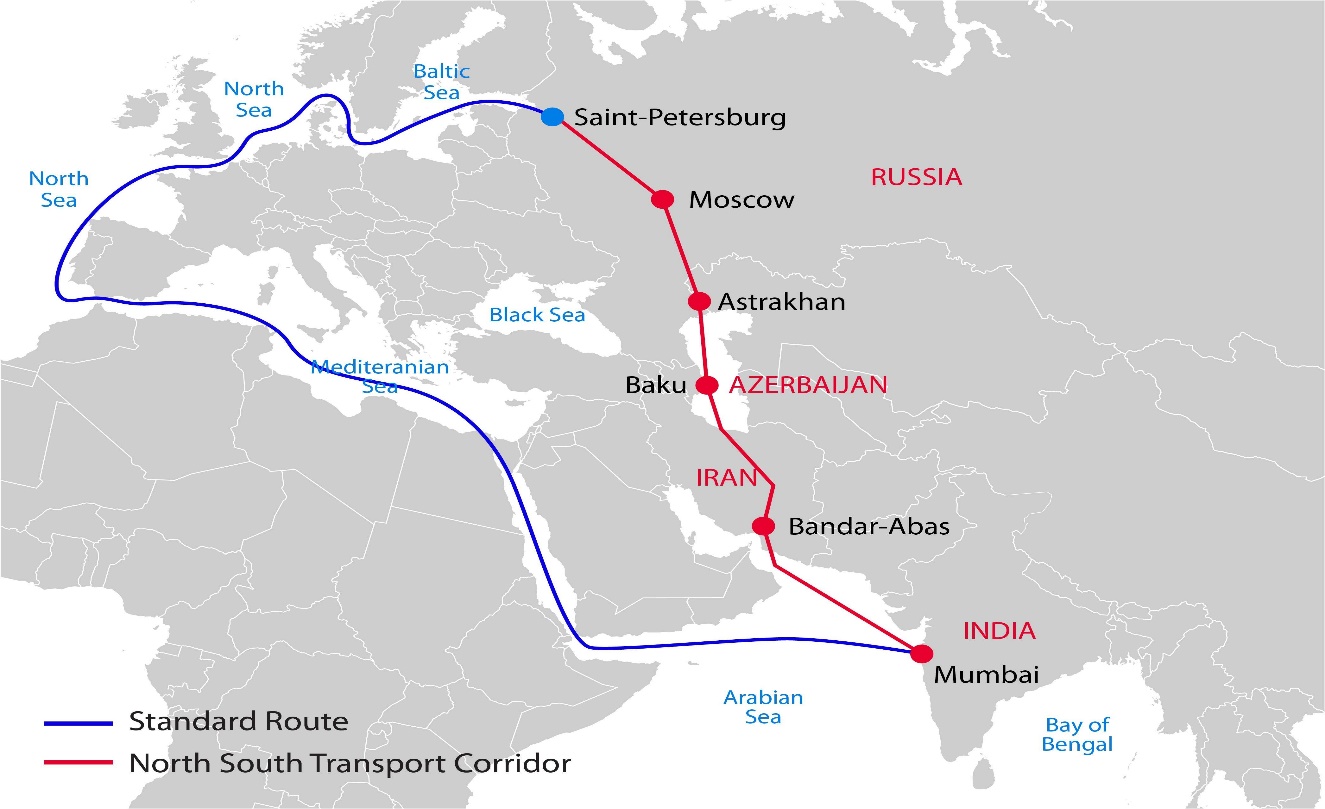
Rash-Astra Railway
- Astara (Azerbaijan), which is located on the border with Azerbaijan, will be connected to Rasht (Iran), a city close to the Caspian Sea, through a 162-kilometer railway. The new link will cut that journey time by four days.
- The Rasht-Astara railway will be a component of the special North-South transport corridor, which will greatly diversify the world's traffic patterns. Significant cost and time savings will result from travel along the new corridor, which will also contribute to the creation of new logistical chains.
- Russian ports on the Baltic Sea and Iranian ports in the Indian Ocean and Gulf would be connected by the railway running along the Caspian Sea coast.
Facts about International North–South Transport Corridor (INSTC)
- It is a 7,200-kilometer multi-mode transit system that links routes for transporting freight by ship, rail, and road connecting India, Iran, Azerbaijan, Russia, Central Asia, and Europe.
- To encourage transport cooperation among the Member States, it was introduced on September 12th, 2000 in St. Petersburg by Iran, Russia, and India.
- Azerbaijan, Armenia, Kazakhstan, Kyrgyzstan, Tajikistan, Turkey, Ukraine, Syria, Belarus, and Oman are now among the ten new nations that have joined INSTC since that time.
- As an observer state, Bulgaria has been added. Additionally expressing interest in joining are the Baltic nations of Latvia and Estonia.
- Routes and Modes:
- Central Corridor: It starts at Mumbai's Jawaharlal Nehru Port and links to Bandar Abbas Port in Iran via the Strait of Hormuz. The route then travels through Iranian territory through Nowshahr, Amirabad, and Bandar-e-Anzali before following the Caspian Sea to the Russian ports of Olya and Astrakhan.
- Western Corridor: Through the cross-border nodal sites of Astara (Azerbaijan) and Astara (Iran), it links the railway networks of Azerbaijan and Iran. From there, it takes a sea route to India's Jawaharlal Nehru port.
- Eastern Corridor: It connects Russia to India via Kazakhstan, Uzbekistan, and Turkmenistan in Central Asia.
Significance of INSTC for India
-
Alternate Route:
- India views INSTC as a different way to communicate with Central Asia, a region that is crucial and abundant in hydrocarbons.
- As a result, a permanent secondary route is established for trade between Afghanistan and Central Asia due to the difficulties in the direct route through Pakistan.
- Through the China Pakistan Economic Corridor (CPEC) and the Gwadar port, both of which are a component of China's Belt and Road Initiative (BRI), China and Pakistan are seeking to improve their economic and trade connections.
-
Decrease Time and Freight Cost:
- INSTC is a network of roads, rails, and sea routes that runs via Chabahar to connect Mumbai, India, with Saint Petersburg, Russia.
- According to projections, the INSTC will cut the travel time in half, from 45 to 60 days to 25 to 30 days. Furthermore, compared to the Suez Canal route, it is expected to reduce freight costs by 30%.
-
Chabahar Port:
- India signed an intergovernmental agreement for the INSTC and invested in the Chabahar Port in the Iranian region of Sistan-Balochistan.
- The Chabahar port is seen as a gateway to lucrative opportunities for India, Iran, and Afghanistan to conduct trade with nations in Central Asia.
- On the Gulf of Oman, in southwest Iran, is the port of Chabahar. The only port in Iran with direct access to the ocean is this one. It is located in the economically prosperous Sistan-Balochistan province of Iran.
- Alternative to Suez Canal: The blockade of the Suez Canal in 2021, which reportedly cost 12% of world trade and delayed goods worth USD 9 billion per day, has boosted confidence in the INSTC as a more affordable and time-efficient multimodal transit route.
- Potential for Baltic Connectivity: With the potential to reach the Baltic, Nordic, and Arctic areas, the INSTC connects India with Central Asia, Russia, and other continents.
- When considered in the context of its underlying commercial benefits, this connection endeavour has the potential to alter the area, supporting not just travel but also humanitarian aid and general economic growth.
- Eurasia's Regional Supply Chains: The stereotype of the East as the producer and the West as the consumer may be altered by the development of diversified supply networks throughout Eurasia.
Challenges
- The World Bank, Asian Development Bank, European Investment Bank, and Islamic Development Bank are only a few of the major international financial institutions that have not provided financial assistance for the bulk of INSTC-related initiatives.
- This is mostly because of the unilateral sanctions that the United States has placed on Iran, which have raised worries about potential "secondary sanctions."
- Following the US's exit from the JCPOA (Joint Comprehensive Plan of Action) in 2018, Iran was subjected to stronger sanctions, which led to the withdrawal of several international corporations from infrastructure projects in Iran.
Way Forward
- The INSTC offers significant promise for a variety of stakeholders, but in order to fully realise those advantages, additional funding, collaboration, political will, and strategic planning are needed.
- Due to the region's political and security risks, funding is a significant obstacle, and private sector participation is constrained. The success of the corridor also depends on the harmonisation of tariffs and customs.
- Improving informational connectivity and creating demand are essential for growing trade volume. Currently, not enough goods are exported from South Asia and Southeast Asia to Europe via the Suez Canal route. The big INSTC project can only be carried out successfully if this demand shortfall is addressed.

Prelims:
Q. What is the importance of developing Chabahar Port by India? (2017)
(a) India’s trade with African countries will enormously increase.
(b) India’s relations with oil-producing Arab countries will be strengthened.
(c) India will not depend on Pakistan for access to Afghanistan and Central Asia.
(d) Pakistan will facilitate and protect the installation of a gas pipeline between Iraq and India.
Ans: (c)

GLACIAL LANDFORMS

Latest Context
Any sizable mass of ice that accumulates on land by the recrystallization of snow or another type of solid precipitation is referred to as a glacier.
Facts about Glaciers
- A glacier is a sizable, perennial deposit of crystalline ice, snow, rock, sediment, and water that forms on land and advances down slope due to the weight and gravity of its own composition. They serve as sensitive indicators of climatic change.
- Glaciers make up 2.1% of the total water on Earth, whereas the oceans and inland seas make up 97.2%.
- Condition of glacier formation:
- Mean annual temperatures are quite close to freezing point.
- Large amounts of snow accumulate as a result of winter precipitation.
- The remaining portion of the year's temperatures prevent the snow accumulation from being completely lost.
Formation of Glacier
- In locations where more snow accumulates each year than melts, glaciers start to develop. The snow starts to compress right away when it falls, or it gets thicker and more densely packed.
- Firnification is the process through which snow condenses into glacial firn (thick, granular ice).
- The firn grains combine into a massive mass of solid ice when the ice is thick enough, which takes around 50 metres (160 feet). The glacier starts to calve as a result of its own weight.
- A glacier's many components move at various rates. The glacier's centre, flowing ice, advances more quickly than its base.
Geographical Location
- Antarctica is home to 91% of the world's glaciers, whereas 8% are in Greenland. They take up around 10% of the earth's surface.
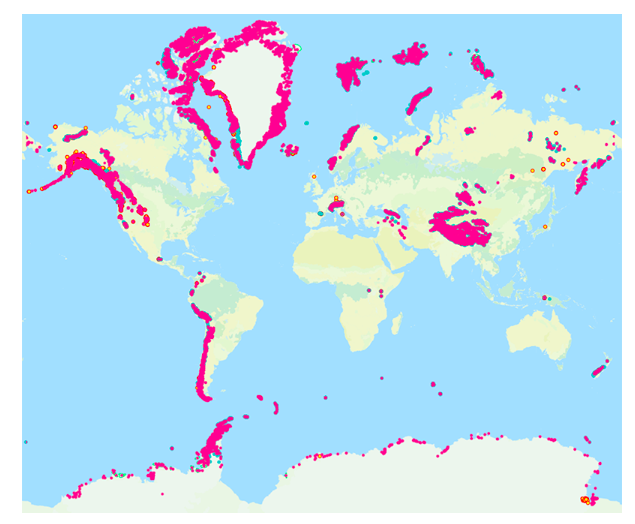
Significance
- Glaciers as Reservoirs: Glaciers hold about 75 percent of the freshwater on Earth. As a result, glacier ice is both the biggest freshwater reservoir and the second largest water reservoir on Earth. Additionally, glacial runoff has an impact on downstream water temperatures.
- Rivers are fed by glaciers: The Ganga River originates in the Gangotri Glacier, one of the biggest glaciers in the Himalayan Mountains. In Bangladesh and India, the Ganges is the primary source of both freshwater and power.
- Glaciers that Support Aquatic Life: In mountainous regions, many aquatic species need cold water temperatures to live, which glaciers supply. It is impossible for some aquatic insects to exist without the cooling effects of glacier meltwater because they are so sensitive to stream temperature.
- Native trout and other keystone salmon species may be negatively impacted by these alterations to the stream ecosystem.
- Glaciers for People: Glaciers provide humanity a variety of beneficial materials. Crops may be grown on rich soil thanks to glacial till. Concrete and asphalt are made from sand and gravel deposits.
Types of Glaciers
- Size (i.e., ice sheet, ice cap, valley glacier, cirque glacier).
- Thermal regime (polar vs. temperate).
Size Based Glaciers
- Ice Cap: An ice cap, like the one on Ellesmere Island in the Canadian Arctic, is a dome-shaped glacier mass that flows in all directions.
- Valley Glaciers: They grow on mountain faces and descend through valleys; they are also known as Alpine Glaciers or Mountain Glaciers. Every continent, with the exception of Australia (although there are several in New Zealand), has high mountains where they may be found. Examples, Furtwangler Glacier in Tanzania and the Gorner Glacier in Switzerland.
- Ice Sheets: Ice sheets are not restricted to hilly regions, unlike valley glaciers. They radiate outward from their centres in the shape of large domes. Continental glaciers, the biggest ice sheets, cover a huge region. The majority of Antarctica and the island of Greenland are covered with continental glaciers.
- Cirque glaciers: They are restricted to cirques, or mountain amphitheatres, and are narrow and short.
Thermal Regime based Glaciers:
- Polar Glacier: A polar glacier is characterised as having all of its bulk at or below the freezing point for the whole year.
- Temperate Glacier: Liquid water coexists with glacier ice in a temperate glacier because it is practically near the melting threshold. They may be found in New Zealand, Asia, Europe, North and South America, Africa, and the Middle East. The southern outlet glaciers of Greenland and some of the glaciers of Antarctica are temperate.
Types of Landforms
- Erosional Landforms.
- Depositional Landforms.
Erosional Landforms
- Glacial Valleys/Troughs: These valleys have vast floors, generally smooth sides, and U-shaped trough-like shapes. The valleys might have strewn rubble or debris in the form of moraines that seem marshy.
- Fjords/fiords are very deep glacier troughs that are filled with sea water and form shorelines (in high latitudes).
- Cirques: They are long, broad, deep troughs or basins with steep, high walls that descend steeply at the head and sides. Examples, glaciated mountains, cirque lakes or tarn lakes.
- Horns and Serrated: The walls of the cirque erode headward, creating horns. Horn-shaped summits with high, sharply pointed, and steeply sloping peaks occur when three or more radiating glaciers cut headward until their cirques meet.
Depositional Landforms
- Glacial Till: Glacial till refers to the mixed-up coarse and fine material that melting glaciers release.
- Moraines: The glacial till deposits are found over long ridges.
- Long ridges of debris called terminal moraines are deposited at the toe (end) of glaciers.
- Along the edges of the glacier valleys parallel to them, lateral moraines develop.
- Ground moraines are the uneven sheets of till that many valley glaciers leave behind when they swiftly recede.
- The term "medial moraine" refers to the moraine that is in the glacier valley's middle and is bordered by lateral moraines.
- Eskers: These are ridges comprised of sand and gravel that have been created by meltwater from glaciers flowing through channels on top of glaciers or via tunnels within and beneath glaciers.
- Drumlins: They are smooth, oval-shaped landforms resembling ridges made primarily of glacial till with minor amounts of gravel and sand.
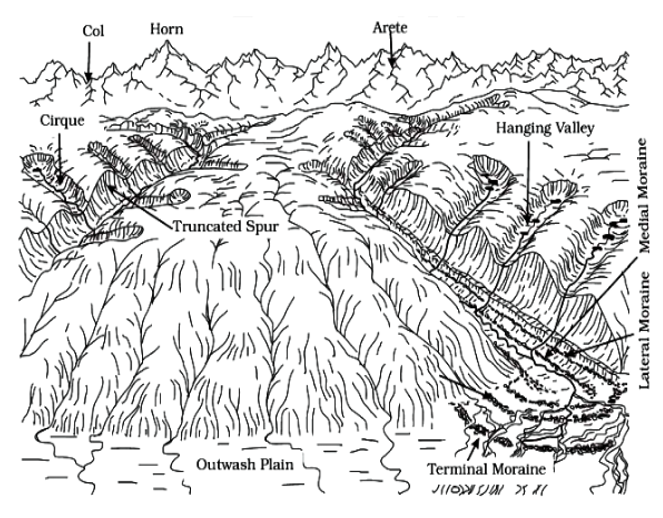
Impact of Climate Change on Glaciers
- Glaciers are shrinking or disappearing altogether.
- It causes of sea level rise.
- Glacier loss is a serious threat to natural and human water supplies in many parts of the world.

PRODUCTION LINKED INCENTIVE FOR IT HARDWARE

Latest Context
An updated Production Linked Incentive (PLI) schemes for Indian IT hardware manufacturing was recently approved by the Union Cabinet. This action is being taken as India's electronics manufacturing sector experiences rapid expansion and crosses a crucial output threshold of USD 105 billion.
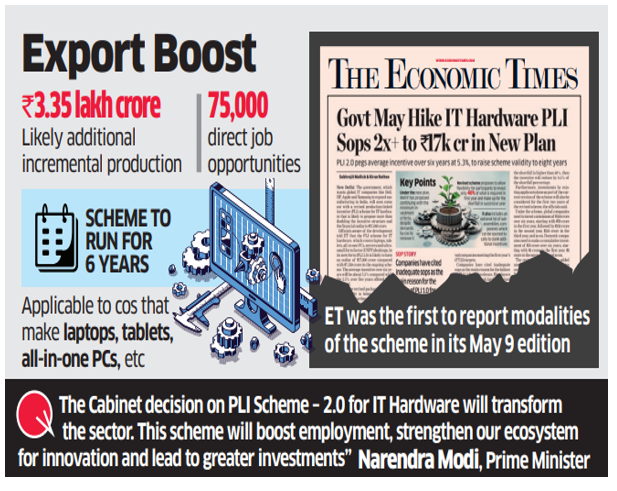
Major Highlights of the Updated PLI Scheme for IT Hardware
- Improvement to the PLI Scheme for IT Hardware: In March 2021, the PLI plan for IT gear was initially announced. The scheme offers qualified firms’ incentives of up to 4% for increased investment in local manufacturing.
- The incentive has been raised to 5% under the revised programme, according to the Ministry of Electronics and Information Technology (MeitY).
- For the use of components made locally, a "additional optional incentive" has also been provided.
- Updated Budgetary Outlay and Duration: A financial allocation of 17,000 crore has been designated for the modified PLI scheme for IT hardware. The scheme will have a tenure of six years, giving companies a longer-term incentive to start up and grow in India.
- Growth of Electronics Manufacturing in India: India's electronics manufacturing industry has grown at a 17% compound annual growth rate (CAGR) during the last eight years.
- CAGR: CAGR stands for the Compound Annual Growth Rate. It is the measure of an investment’s annual growth rate over time, with the effect of compounding taken into account. It is often used to measure and compare the past performance of investments or to project their expected future returns.
- India exceeded USD 11 billion in mobile phone exports in 2023, securing its place as the world's second-largest mobile handset producer, behind only China.

Facts about Production-Linked Incentives Scheme (PLI)
- The 'AatmaNirbhar Bharat Abhiyan' (Self-Reliant India) initiative's latest reform is the Production-Linked Incentives (PLI) plan.
- Goal: To provide companies with incentives based on increased sales of goods made in India over the base year.
- The programme also encourages international companies to establish units in India.
- Objective: The scheme's goals are to increase domestic manufacturing's competitiveness abroad and to produce manufacturing world champions.
- They have been particularly created to promote domestic manufacturing in important and emerging sectors, to lower import costs and cheaper imports, to increase domestic capacity and exports, and to improve the cost competitiveness of locally produced goods.
- Announced Sectors for PLI: 14 important sector that were chosen for the PLI programmes based on their potential to generate revenue and jobs were given an allocation of INR 1.97 lakh crores in the Union Budget 2021–22.
- The 14 sectors include solar PV modules, advanced chemistry cell (ACC) batteries, drones and drone parts, as well as the manufacturing of mobile devices, medical devices, automobiles and auto components, pharmaceuticals, drugs, specialty steel, telecom & networking products, electronics, white goods (ACs and LEDs), food products and textile products.


NIA's Operation Dhvast
- Recent nationwide operations by the National Investigation Agency (NIA) named "Operation Dhvast" targeting the interconnected network of terrorists, gangsters, and drug traffickers.
- The NIA conducted 129 searches across many states in conjunction with the Punjab and Haryana police, leading to the detention of three people.
- The aim of the operation was to dismantle the terrorist network of infamous criminals, terrorists, and those financing pro-Khalistan organisations through terror, extortion, and the smuggling of narcotics and weapons.
- The Indian government created the National Investigation Agency (NIA) in 2009 to look into and punish offences involving terrorism, insurgency, and national security.
- It is governed by the Ministry of Home Affairs and has authority over issues that concern the entire nation.
- The National Investigation Agency (NIA) Act of 2008, which established the NIA in reaction to the 2008 terrorist attacks in Mumbai, governs its operations.
- The National Investigation Agency (Amendment) Act of 2019 gave the agency more authority.
- The NIA is empowered to take over cases involving terrorism from state police forces and other agencies, and it is free to conduct investigations across state lines without seeking prior approval from the state governments.
- Its duties also include collaborating with law enforcement organisations inside and outside of India, gathering, analysing, and distributing intelligence on terrorism and national security, and bringing cases before the NIA Special Court.
- It requests the Central government's approval before bringing charges against suspects under the Unlawful Activities (Prevention) Act (UAPA) and other listed offences.
Caste-Based Survey
- The interim stay order imposed on the caste-based survey in Bihar by the Patna High Court has been refused to be lifted by the Supreme Court of India.
- The Bihar government launched the survey to gather information on the socio-economic status and educational level of the state's various castes.
- The Supreme Court further stated that it was necessary to evaluate whether the survey was a voluntary exercise or a census.
- The practise of gathering data on the population of various castes in an area or a country is known as a caste-based survey.
- Social stratification based on birth, profession, and religion is known as caste. Caste-based surveys are frequently carried out to identify the backward classes and provide them welfare schemes and reservation.
- Caste-based surveys are, however, especially controversial since they may have an impact on social harmony, political representation, and personal privacy.
- Article 340 mandates the appointment of a commission to investigate the conditions of socially and educationally backward classes and make recommendations as to the steps that should be taken by governments.
e-Malkhana
- By June 2023, all 23 police stations within the Visakhapatnam Police Commissionerate in Andhra Pradesh will be equipped with e-Malkhana, a scientific storage system for property and evidence seized from crime scenes.
- The project aims to make the process of keeping recovered goods more effective and organised. Property and evidence used to be kept in conventional storerooms, which made recovery challenging.
- The confiscated goods and evidence will be kept in standardised cardboard boxes with e-Malkhana, each labelled with a special number and extra information.
- The box will be given a dynamic QR code that will be printed on it and provide quick scanning access to case-related data. By streamlining the storage and retrieval procedure, this technological advancement gives law enforcement authorities more convenience and transparency.
MoU Between CCI and ECA
- The Memorandum of Understanding (MoU) between the Egyptian Competition Authority (ECA) and the Competition Commission of India (CCI) has been approved by the Union Cabinet.
- The Memorandum of Understanding (MoU) outlines how cooperation in competition law and policy would be promoted and strengthened through information sharing, the sharing of best practises, and different capacity-building activities.
- Through experience exchange and technical collaboration, the MoU also seeks to deepen ties between CCI and ECA as well as learn from and model each other's approaches to enforcing competition legislation in their respective countries.
- In order to carry out its obligations or carry out its powers under the Competition Act of 2002, Section 18 of the Act gives CCI permission to engage into any agreement or memorandum with any foreign agency.
- The Competition Act of 2002 governs competition in the Indian market and outlaws’ anti-competitive actions including cartels, the abuse of market dominance, and mergers and acquisitions that might harm competition.
- By the Competition (Amendment) Act of 2007, the Act has been modified.
Must Check: IAS Coaching Centre In Delhi


